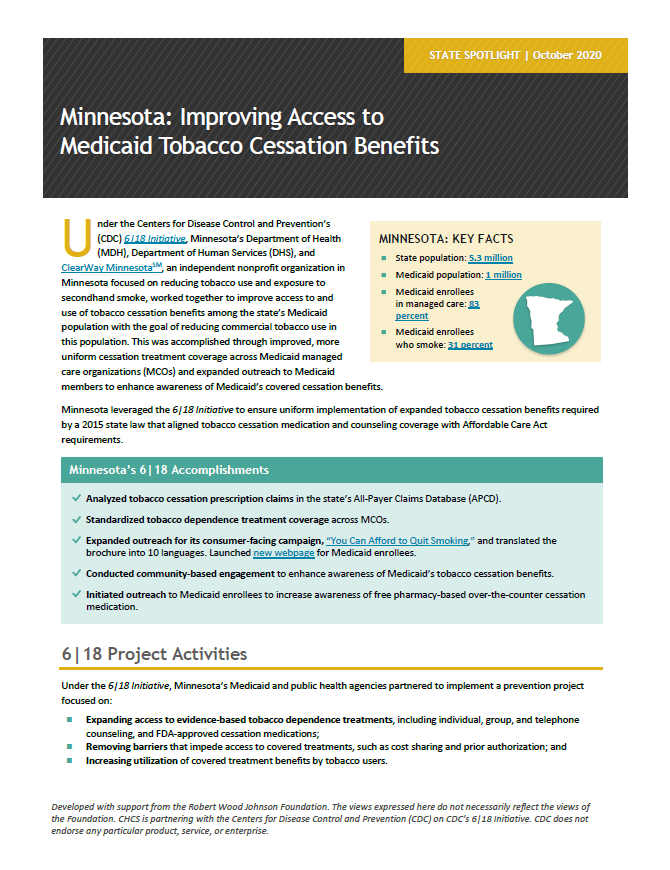Minnesota: Improving Access to Medicaid Tobacco Cessation Benefits
October 2020 | 6|18 Initiative State Spotlight
Under the Centers for Disease Control and Prevention’s (CDC) 6|18 Initiative, Minnesota’s Department of Health (MDH), Department of Human Services (DHS), and ClearWay MinnesotaSM, an independent nonprofit organization in Minnesota focused on reducing tobacco use and exposure to secondhand smoke, worked together to improve access to and use of tobacco cessation benefits among the state’s Medicaid population with the goal of reducing commercial tobacco use in this population. This was accomplished through improved, more uniform cessation treatment coverage across Medicaid managed care organizations (MCOs) and expanded outreach to Medicaid members to enhance awareness of Medicaid’s covered cessation benefits.
Minnesota leveraged the 6|18 Initiative to ensure uniform implementation of expanded tobacco cessation benefits required by a 2015 state law that aligned tobacco cessation medication and counseling coverage with Affordable Care Act requirements.
MINNESOTA KEY FACTS
- State population: 3 million
- Medicaid population: 1 million
- Medicaid enrollees in managed care: 83 percent
- Medicaid enrollees who smoke: 31 percent
Minnesota’s 6|18 Accomplishments
- Analyzed tobacco cessation prescription claims in the state’s All-Payer Claims Database (APCD).
- Standardized tobacco dependence treatment coverage across MCOs.
- Expanded outreach for its consumer-facing campaign, “You Can Afford to Quit Smoking,” and translated the brochure into 10 languages. Launched new webpage for Medicaid enrollees.
- Conducted community-based engagement to enhance awareness of Medicaid’s tobacco cessation benefits.
- Initiated outreach to Medicaid enrollees to increase awareness of free pharmacy-based over-the-counter cessation medication.
6|18 Project Activities
Under the 6|18 Initiative, Minnesota’s Medicaid and public health agencies partnered to implement a prevention project focused on:
- Expanding access to evidence-based tobacco dependence treatments, including individual, group, and telephone counseling, and FDA-approved cessation medications;
- Removing barriers that impede access to covered treatments, such as cost sharing and prior authorization; and
- Increasing utilization of covered treatment benefits by tobacco users.
Specific activities undertaken by the partners include:
 1. In-Depth Survey of MCOs
1. In-Depth Survey of MCOs
The Medical Director’s Office of the Medicaid program, the Health Promotion and Chronic Disease Office and the Tobacco Prevention and Control Unit within the Department of Health, and ClearWay Minnesota partnered to launch Minnesota’s 6|18 initiative project. Minnesota’s public health leadership joined the project to enhance existing collaborations with Medicaid.
The team surveyed the state’s nine Medicaid MCOs to gather detailed information on the landscape of tobacco cessation benefit policies. The survey asked plans about treatments covered, copays, prior authorization, quantity limits, and communications with enrollees about available services. Survey results provided clarity on benefits provided by MCOs and found variation by plan in some areas. In instances where an MCO’s policy was not in accordance with Minnesota legislation requiring the removal of cost-sharing for counseling and medications, the Medicaid office clarified the new requirements and the MCO implemented the policy changes.
The process of surveying and engaging with MCOs on their cessation benefits resulted in improved and more uniform coverage. It also expanded the agencies’ knowledge of the depth of coverage that enrollees could access.
 2. Analysis of Smoking Outcomes and Cessation Utilization
2. Analysis of Smoking Outcomes and Cessation Utilization
Minnesota conducted extensive data analyses to monitor smoking outcomes and cessation treatment utilization among Medicaid enrollees. The team engaged in a multi-faceted analytic approach using both the APCD and Medicaid Consumer Assessment of Healthcare Providers and Systems (CAHPS) data. The primary data source was the APCD, which was used to conduct a baseline analysis of 2014 utilization of cessation treatments, including cessation medications and cessation counseling. Medicaid also tracked enrollees’ medication prescriptions through the APCD. The 6|18 team used Medicaid CAHPS data to examine how treatment utilization varied across MCOs. CAHPS data is based on MCO member surveys and is routinely submitted to Medicaid as part of quality monitoring.
 3. Expanded Campaign Outreach
3. Expanded Campaign Outreach
Minnesota’s 6|18 team invested in resources to expand their outreach for consumer-facing tobacco cessation campaigns. This included the primary campaign, “You Can Afford to Quit Smoking.” In partnership with ClearWay Minnesota, the Medicaid-public health team developed a brochure that increased provider and enrollee awareness that Medicaid pays for free cessation services. Roughly 23,000 copies of the brochure were distributed electronically and physically. A separate tool for providers described billing information related to cessation services. MDH worked with community-based organizations and grantees to enhance awareness of available tobacco cessation services and benefits.
State Spotlights: Medicaid-Public Health Collaboration in CDC’s 6|18 Initiative
This profile is part of a series, developed by the Center for Health Care Strategies and made possible by the Robert Wood Johnson Foundation, that showcases how state Medicaid and public health departments are using the Centers for Disease Control and Prevention’s (CDC) 6|18 Initiative to accelerate the adoption of evidence-based prevention efforts focused on improving health outcomes and controlling health care costs. The CDC’s 6|18 Initiative links proven prevention activities to health coverage and delivery with a focus on six high-burden, high-cost health conditions — tobacco use, high blood pressure, inappropriate antibiotic use, asthma, unintended pregnancies, and diabetes.
